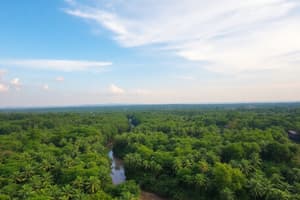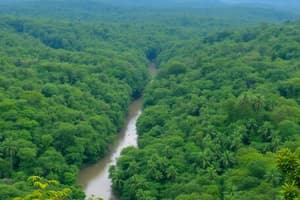Podcast
Questions and Answers
What are the Amazon rainforests also known as?
What are the Amazon rainforests also known as?
- The Earth's mantle
- The world's garden
- Tropical paradise
- Selvas (correct)
The Amazon rainforests produce more than 50% of the world's oxygen.
The Amazon rainforests produce more than 50% of the world's oxygen.
False (B)
What architectural feature of the rainforest allows it to block sunlight?
What architectural feature of the rainforest allows it to block sunlight?
canopy
The Amazon forest floor is usually covered in pitch __________.
The Amazon forest floor is usually covered in pitch __________.
Match the following animals to their habitat within the Amazon rainforest:
Match the following animals to their habitat within the Amazon rainforest:
What makes the soil in the Amazon rainforest challenging for plants?
What makes the soil in the Amazon rainforest challenging for plants?
Lianas are plants that grow on the forest floor.
Lianas are plants that grow on the forest floor.
Name the plant that has adapted to survive the rainfall by having leaves with pointed tips.
Name the plant that has adapted to survive the rainfall by having leaves with pointed tips.
__________ are plants that thrive on high branches in the forest canopy, obtaining nutrients from the air and water.
__________ are plants that thrive on high branches in the forest canopy, obtaining nutrients from the air and water.
Match each plant adaptation to its purpose in the rainforest:
Match each plant adaptation to its purpose in the rainforest:
Which of the following is NOT a common species found in the Amazon rainforest?
Which of the following is NOT a common species found in the Amazon rainforest?
The Amazon rainforest has a low diversity of animal species.
The Amazon rainforest has a low diversity of animal species.
Name two mammals found in the Amazon rainforest.
Name two mammals found in the Amazon rainforest.
The __________ is one of the largest freshwater fish found in the Amazon rainforest.
The __________ is one of the largest freshwater fish found in the Amazon rainforest.
Match the animal with its adaptation:
Match the animal with its adaptation:
What is the purpose of the grey-brown fur of two-toed sloths?
What is the purpose of the grey-brown fur of two-toed sloths?
Most plants in the Amazon rely solely on the soil for their nutrients.
Most plants in the Amazon rely solely on the soil for their nutrients.
Explain the unique adaptation of the flying frog that helps it navigate the rainforest.
Explain the unique adaptation of the flying frog that helps it navigate the rainforest.
The dense canopy of the Amazon rainforest results in a __________ environment on the forest floor.
The dense canopy of the Amazon rainforest results in a __________ environment on the forest floor.
Match the plant species with their use or characteristic:
Match the plant species with their use or characteristic:
How does the presence of broad leaves in the Amazon Rainforest contribute to it's physical environment?
How does the presence of broad leaves in the Amazon Rainforest contribute to it's physical environment?
The acidic soil of the Amazon rainforest benefits all plant species equally.
The acidic soil of the Amazon rainforest benefits all plant species equally.
Describe the adaptations that enable epiphytes to thrive in the canopy of the Amazon rainforest, contrasting their nutrient acquisition with that of soil-rooted plants.
Describe the adaptations that enable epiphytes to thrive in the canopy of the Amazon rainforest, contrasting their nutrient acquisition with that of soil-rooted plants.
The evolutionary adaptation of __________ fur in two-toed sloths serves as a strategic survival mechanism by minimizing detection from predators within the Amazon rainforest's intricate arboreal environment.
The evolutionary adaptation of __________ fur in two-toed sloths serves as a strategic survival mechanism by minimizing detection from predators within the Amazon rainforest's intricate arboreal environment.
Which factor contributes most significantly to the pitch darkness on the Amazon forest floor?
Which factor contributes most significantly to the pitch darkness on the Amazon forest floor?
Which term accurately describes plants that grow non-parasitically on other plants within the rainforest canopy?
Which term accurately describes plants that grow non-parasitically on other plants within the rainforest canopy?
Due to the high levels of biodiversity in the amazon rainforest, there is little to no competition for resources.
Due to the high levels of biodiversity in the amazon rainforest, there is little to no competition for resources.
Describe the unique adaptation of the flying frog and its ecological significance in the Amazonian rainforest.
Describe the unique adaptation of the flying frog and its ecological significance in the Amazonian rainforest.
In the Amazon rainforest, __________ such as lianas utilize neighboring trees for structural support as they ascend towards sunlight, showcasing a cooperative adaptation strategy within this competitive ecosystem.
In the Amazon rainforest, __________ such as lianas utilize neighboring trees for structural support as they ascend towards sunlight, showcasing a cooperative adaptation strategy within this competitive ecosystem.
Match each animal in the Amazon rainforest with its respective adaptation showcasing survival mechanisms.
Match each animal in the Amazon rainforest with its respective adaptation showcasing survival mechanisms.
Flashcards
Amazon Rainforest
Amazon Rainforest
The largest tropical rainforest in the world, also known as 'selvas'.
Rainforest Canopy
Rainforest Canopy
A dense layer of treetops that blocks sunlight from reaching the forest floor.
Epiphytes
Epiphytes
Plants that live on high branches in the forest canopy and get nutrients from air and water.
Lianas
Lianas
Signup and view all the flashcards
Adaptations
Adaptations
Signup and view all the flashcards
Camouflage
Camouflage
Signup and view all the flashcards
Study Notes
- The Amazon forests are the largest tropical rainforest in the world.
- The Amazon forests are known as selvas.
- The Amazon forests are referred to as the 'lungs of the Earth'.
- The Amazon forests take in carbon dioxide and release oxygen.
- More than 20% of the world's oxygen is produced by the Amazon rainforest.
- The Amazon rainforests are home to a vast variety of flora and fauna.
- Hardwood trees are closely placed with broad leaves, forming a thick canopy on top.
- The canopy blocks sunlight from reaching the forest floor, resulting in a dense, dark, and damp environment.
- The soil in this region is generally infertile and acidic, making it challenging for plants to access nutrients.
- Plants in the rainforest have evolved unique characteristics to survive.
- Vines are climbing or trailing woody-stemmed plants related to the grapevine.
- Vines, such as lianas, wrap around other trees to sustain themselves.
- Many plants have leaves with pointed tips that allow water to run off without causing damage.
Did You Know
- The Amazon forest floor is usually covered in pitch darkness.
- Thick and interwoven top branches and leaves of the trees form a dense canopy.
- The canopy is so thick that it takes around ten minutes for the rainwater to reach the ground.
Epiphytes
- Epiphytes are plants that thrive on high branches in the forest canopy.
- Epiphytes obtain their nutrients from the air and water rather than the soil.
- Ferns, orchids, mosses, algae, and lichens are all epiphytes.
- Palm, rubber, cane, balsa, cacao, banana tree, cinchona (quinine), and carnauba palm trees are among the most commonly found species in the Amazon forests.
- The Amazon rainforest is home to a diverse range of animals, including mammals like monkeys, tapirs, pumas, jaguars, sloths, anteaters, and armadillos.
- The Amazon Rainforest is home to a diverse range of wildlife, including pythons, crocodiles, alligators, turtles, ants, beetles, butterflies, and over 2000 varieties of fish, including piranhas, pirarucu, and tambaqui.
- Many bird species are found in the Amazon rainforest, like hummingbirds, toucans, parrots, and macaws.
- River dolphins like the Amazon River dolphin and the Amazonian manatee can be found in the rivers and tributaries of the Amazon Basin.
Tropical Rainforest Adaptations
- Tropical rainforests have unique conditions that have led to many adaptations in animals.
- The spider monkey has long and powerful limbs that aid in its tree-climbing.
- The flying frog has fully webbed hands and feet and a flap of loose skin stretching between its limbs, allowing it to glide smoothly from one plant to another.
- Three-toed sloths have tan coats.
- Two-toed sloths usually have grey-brown fur that matches the color of tree trunks and branches, providing excellent camouflage and making it challenging for predators to locate them.
Studying That Suits You
Use AI to generate personalized quizzes and flashcards to suit your learning preferences.




